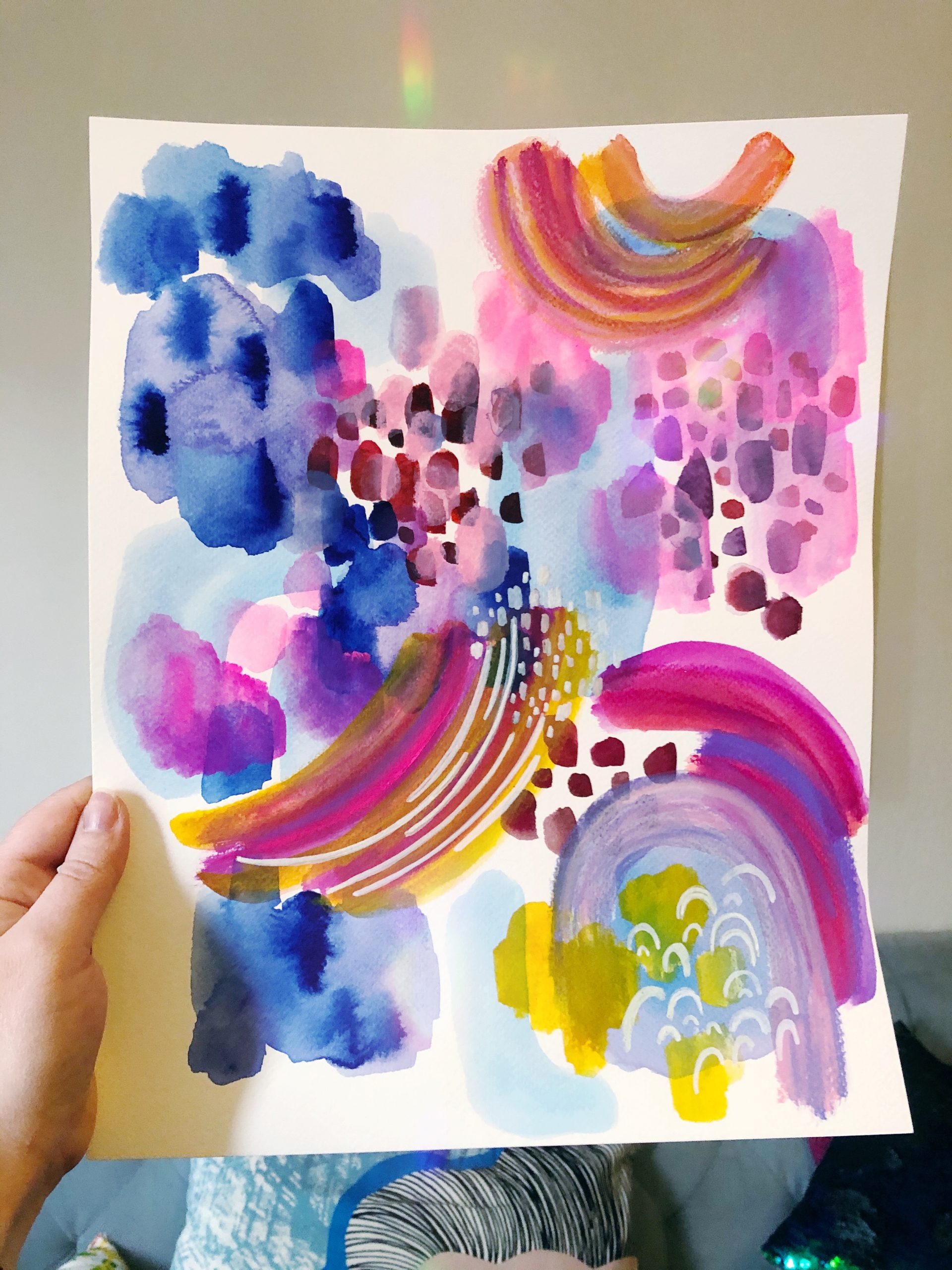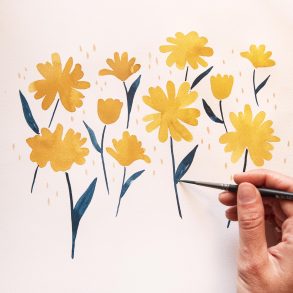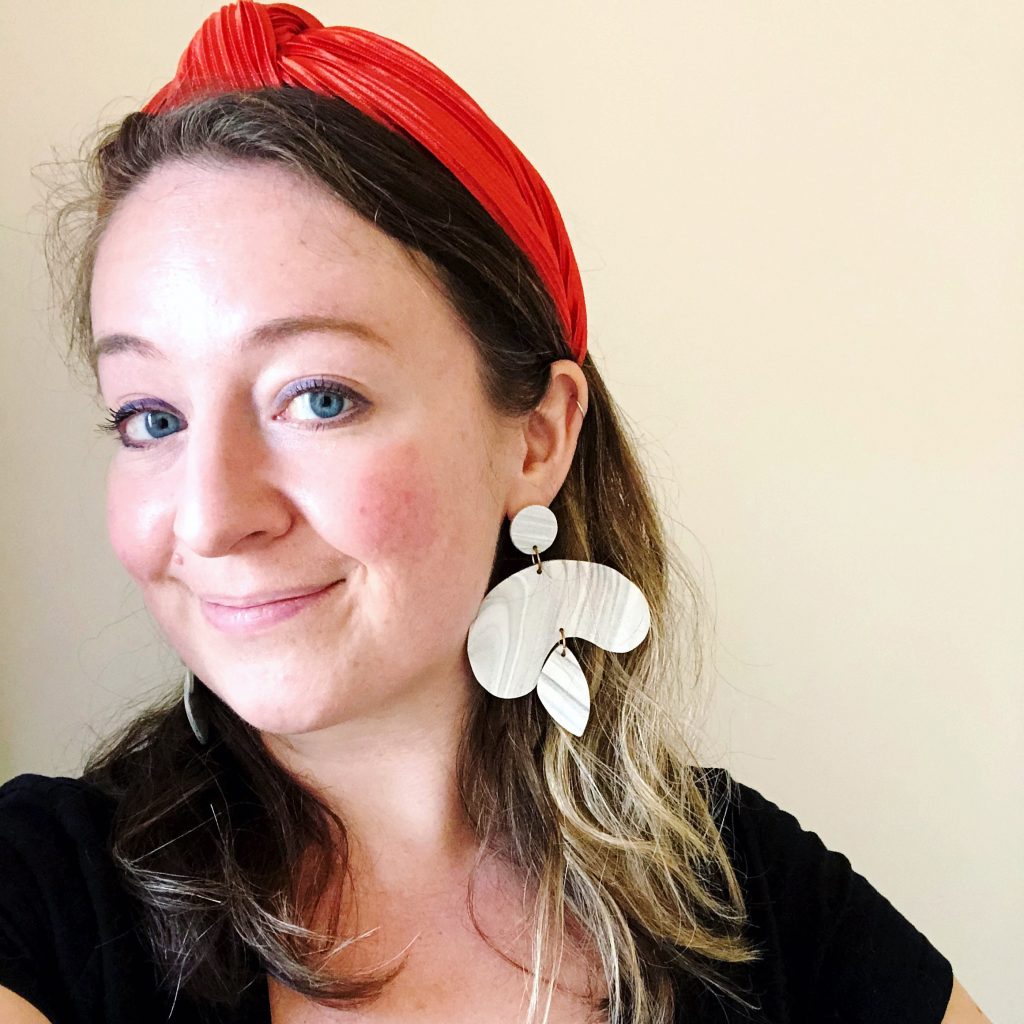
Last week we were delighted to welcome the oh-so-talented Bryna Shields as a guest expert in the Textile Design Lab. Bryna hosted a training event for Lab members in which she shared her creative methods for connecting with her intuition and how you can turn a page of scribbles into something you love!
We hope you enjoy learning more about Bryna in today’s interview!
Welcome Bryna! Can you tell us a bit about your design background and career path? How did you become interested in the world of patterns and surface design?
In college I studied photography and graphic design, and then graduated in the aftermath of the 2008 economic crash. This meant that the traditional career path I’d been preparing for wasn’t a reality anymore – I’m thankful for that now because I’ve been able to create a career that I love over the years. My first few years out of college I cobbled together a living with various freelance gigs in photography and design while I tried to figure out what I wanted to do long term.
I stumbled upon surface design during a Pinterest scrolling rampage after a particularly difficult breakup. At the time I was living alone for the first time, my freelance work had dried up, and I was trying to transition from graphic design to illustration, so surface design was a natural extension of the path I was pursuing. From the first time I learned how to use the Pattern Tool, I was hooked. I loved that surface design allowed me to utilize my interests in painting, collage, photography and drawing. I spent that whole summer obsessively making patterns and finding my groove, and then landed a contract as a surface designer for Crate and Barrel. I learned so much about the ins and outs of home product design during my time there, for which I’m so grateful.
I then moved to Portland, OR where there is an incredible creative community and endless possibilities for exploration. I’ve continued to grow my expertise in the home product design field through designing for Kroger. Working on a large variety of products has given me a lot of insight into how to create art for different materials, how consumers make decisions, and how to develop entire product collections.
Since there is such an expansive creative community here, my art practice has expanded to include weaving and working with clay. I’ve found that playing with different media informs my pattern designs and vice versa.
Throughout all of these explorations and transitions, my love for surface design is rooted in its endless possibilities – I’m always astounded at the ways one print can make an impact in different contexts, and that the process of creating a pattern in and of itself is so fun and freeing. It has expanded the way I think about life in general, looking for new possibilities in everything or rethinking old ideas to give them new life. All of those skills I’ve learned from being a surface designer, and that has been a wonderful gift.
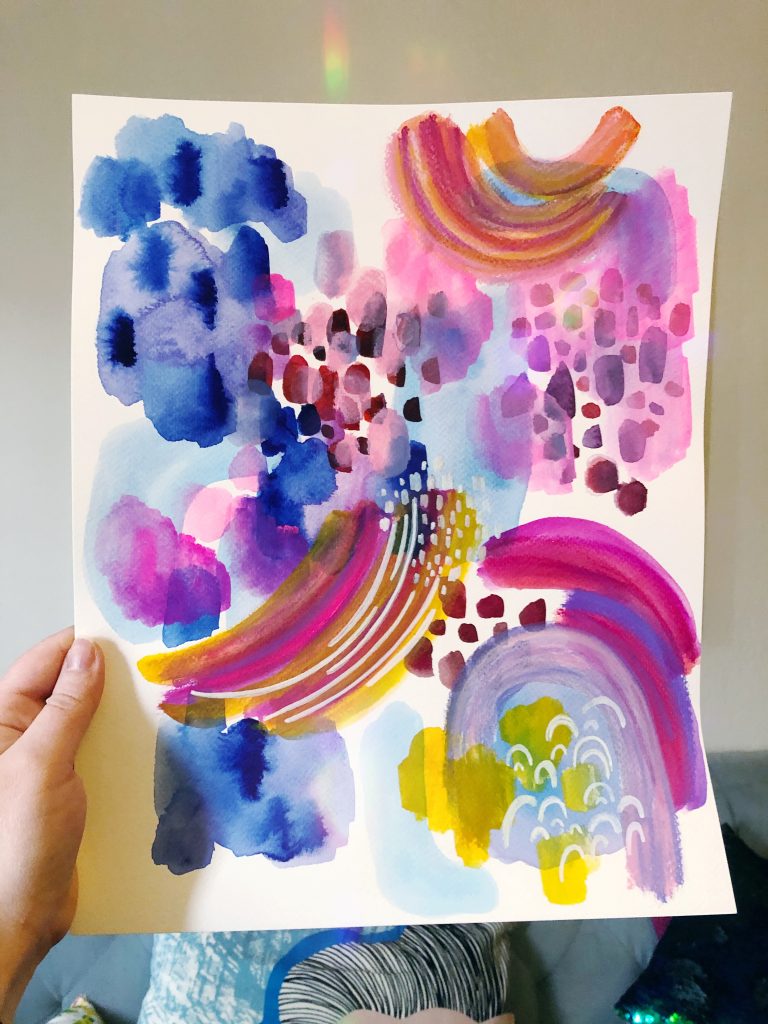
Can you tell us about your creative process and the different disciplines you pursue? Why is experimentation important to your process?
Experimentation is what keeps things fresh for me, and it forces my brain to keep considering new potential. My challenge is always to “surprise myself” – if I can do that, I feel like I’ve been successful. My patterns and illustrations always include whatever I’m compelled to play with in the moment – for instance if I’m feeling too stuck in my head, I might turn to watercolor or collage because they allow me to focus on the physicality of the medium, where other times I might want to mess around with more photographic/textural patterns which activates a different part of my brain.
I love to travel and explore the outdoors, so I often use photos from my adventures as inspiration for sketches and patterns.
My recent studies in personal development and spirituality have also contributed to my creative practice, which has now become integrated into the way I connect to myself and the world in a deeper way. This includes deepening my meditation practice, which has been so helpful in clearing away mental clutter, being comfortable with difficult emotions, and working through new visions for the future. When I can give my mind new channels for all my thoughts, it opens up my creativity in new ways.
What is inspiring you lately?
I’ve been getting into a lot of movement practices lately – this year I started learning how to pole dance, which has been a really wonderful way to find new avenues for self expression. I’ve also been rock climbing and kayaking, which are both ways I get to experience nature in new ways that I love.
A few years ago I studied to become a yoga teacher, and in the process learned about the chakra system, which I’ve been revisiting a lot lately. I’ve also started learning about human design and enneagram. I love to nerd out about the different ways we can make sense of ourselves and existence.
Can you talk about how you’ve integrated the concept of mindfulness into your work? Do you have any suggestions or resources for people during this difficult moment in the world?
Practicing mindfulness and connecting with my intuition have been powerful in navigating change. The more I’ve connected with my intuition, the more I’m able to connect to the present moment. Learning how to offer myself compassion has been really helpful especially during this time. Learning how to be super present with whatever feelings or thoughts come up, even if they’re uncomfortable. Mindfulness has helped me sit in the discomfort. I used to push away “negative” feelings, but now I let them stay, I examine those thoughts and look at them as an opportunity to understand myself and the world more clearly. My creative practice has become a tool for grounding, processing, celebrating, grieving and above all, acceptance of the full range of our existence.
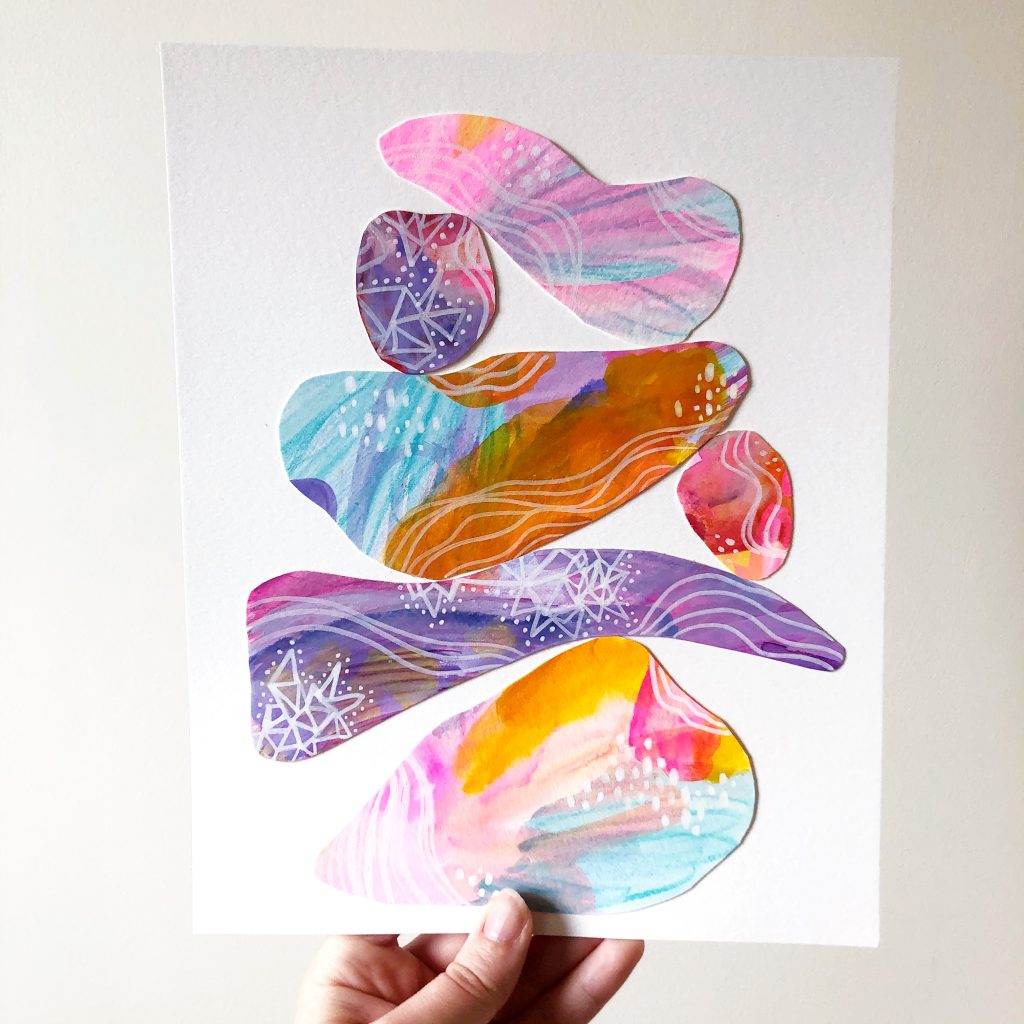
For anyone else who is struggling, I think right now is a potent time to cultivate a deeper relationship with yourself, to learn and advocate for your needs and desires, and to embrace them unabashedly. The more we can connect with our own authentic selves, the more connected we become to the collective, and I think that shines through in whatever you’re creating.
What actions or decisions have made the biggest impact on your design business over the years?
This year I took a leap and enrolled in Marie Forleo’s B-School. It was one of the first times I’ve made a big investment in myself. Her program has been so transformational in helping me understand my purpose and business on a deeper level. I found so much freedom in the way she teaches about business – it has allowed me to envision a business that seamlessly combines my love for art with my interests in personal development and spirituality.
Over the years, the thing that has made the biggest impact has been to try all the things I wanted to try. When I graduated from college, I kept receiving advice about how you have to focus on only one discipline, or you’ll look unfocused or flaky to employers. But as a young person, and someone who loves to explore, that advice never sat well with me. I’m glad I never took that advice because now I truly have a “niche” business that includes a variety of mediums, all unified by a few central themes. Building a business this way is definitely more messy because you have to carve out the path yourself and there aren’t rules that will necessarily guide you along the way, but you’ll end up with something that feels authentic to you and your values.
What have been some of the biggest challenges you have faced in your career and how have you tackled them?
It has definitely been a challenge to find a way to combine the things I’m most passionate about into my business. I’m still trying to let go of the internalized messages about what I “should” be doing. Because I have so many interests, I have a tendency to want to do everything! So lately I’ve been trying to be extra aware of what’s for my business, and what’s just for me as a human. This is often tricky for artists because it’s such a personal field. Taking business courses and talking with other creatives has definitely helped me process these struggles and move in a direction that feels good.
What would you consider to be your proudest moment or greatest success in your career so far? What are your goals for the future?
I’m really proud that I’ve been able to create a career I’m passionate about. As creatives, we’ve internalized so many narratives about the “starving artist” or how unrealistic it is to be an artist full time, but it’s absolutely possible to make a living as an artist, and I’m proud that I didn’t let those narratives influence my dreams. This is my wish for other creatives – that you don’t let the limiting beliefs of other people influence the kind of career or life you want to build. I felt so defeated when I graduated college, because the job market was so bad, and the only career path we’d learned about was a full time job. I thought I was a failure for not being able to secure full time work. As soon as I released the vision that was handed to me by someone else, that’s when the real possibilities and freedom opened up! Remember that often when people are doubtful about your dreams, it’s because they’re projecting their own limitations onto you. It’s not always easy but it is possible to create what you want.
As for the future, I recently launched a podcast called Passion and Possibility, exploring our creative super powers, and I’m looking forward to seeing how that evolves in the future. I’m also working on building a community on Patreon where we can collectively explore creativity as a tool for healing, growth and freedom. I’m really looking forward to inviting community and teaching into my future business plans, because I’m endlessly inspired by the ways other people’s minds work!

What advice have you received in your career that has stayed with you or influenced you?
I had a painting professor in college who would look at a tiny section of our paintings and exclaim “I LOVE this little moment right here!” She would get SO excited about an expressive brush stroke or a tiny detail that would have been easy to miss. It completely changed the way I see and make art.
She showed me that making art is about so much more than the final product, and that there is potential in every piece you make. That has become a central tenet in how I practice art and also how I teach art to others: to look for the possibilities in every creative session. You may not like the final product, but you will likely have created SOMETHING within your work that you can expand upon. That’s where the magic happens.
Do you have any words of wisdom for designers considering a career in the surface design industry?
Follow your curiosities! And I mean that both in an artistic and a career sense. There are so many ways to create work that is impactful and beautiful, you can explore the possibilities of just ONE sketch over and over again and come up with different results. That’s what makes it so magical! I firmly believe that following your curiosities is what leads to a strong authentic voice and vision.
Can you tell us more about the training that you offered to our Textile Design Lab members?
I discussed methods for connecting to your intuition on a daily basis, and shared a guided meditation that I wrote for creatives. I then taught a few drawing exercises that you can use to get out of your head and into an intuitive flow, and showed designers how they can take a page of scribbles and turn it into something they love!
Join us in the Textile Design Lab to access Bryna’s training, and all the creative exercises found in our recent Summer of Creativity course.

